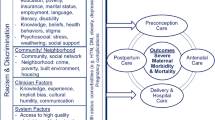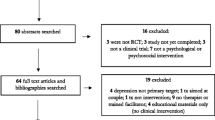Abstract
The adverse consequences of postpartum depression on the health of the mother and her child are well documented. However, there is little information on postpartum depression among mothers with disabilities. This study examines the patterns of depression and depressive symptoms before, during and after pregnancy and the association between depression before and during pregnancy and postpartum depression symptomatology (PPD) among women with and without disabilities. Data from the 2009–2011 Rhode Island Pregnancy Risk Assessment Monitoring System (PRAMS) were analyzed in 2013. Almost 30 % (28.9 %; 95 % CI 22.8–35.8) of mothers with disabilities reported often or always feeling down, depressed or sad after childbirth compared to 10 % of those without disabilities (95 % CI 8.9–11.3). Compared to other women in the study, women with disabilities had a greater likelihood for PPD symptoms (RR 1.6, 95 % CI 1.1–2.2) after accounting for sociodemographics, maternal characteristics related to PPD, and depression before and during pregnancy. Adjusting for other covariates, self-reported prenatal diagnosis of depression was not associated with symptoms of PPD and depression during pregnancy was marginally associated with PPD symptomatology for women with disabilities. Women with disabilities are at a greater risk of experiencing symptoms of postpartum depression than other women. Screening for PPD among new mothers with disabilities and timely referral of those with PPD diagnosis are vital to the health of mothers with disabilities and their children.
Similar content being viewed by others
References
Signore, C., Spong, C. Y., Krotoski, D., Shinowara, N. L., & Blackwell, S. C. (2011). Pregnancy in women with physical disabilities. Obstetrics and Gynecology, 117(4), 935.
Smeltzer, S. C. (2007). Pregnancy in women with physical disabilities. Journal of Obstetric, Gynecologic, and Neonatal Nursing, 36(1), 88–96.
Iezzoni, L. I., Yu, J., Wint, A. J., Smeltzer, S. C., & Ecker, J. L. (2013). Prevalence of current pregnancy among US women with and without chronic physical disabilities. Medical Care, 51(6), 555–562.
Walsh-Gallagher, D., Sinclair, M., & Mc Conkey, R. (2012). The ambiguity of disabled women’s experiences of pregnancy, childbirth and motherhood: A phenomenological understanding. Midwifery., 28(2), 156–162.
Chakravarty, E. F., Nelson, L., & Krishnan, E. (2006). Obstetric hospitalizations in the United States for women with systemic lupus erythematosus and rheumatoid arthritis. Arthritis and Rheumatism, 54(3), 899–907.
Rogers, J., & Matsumura, M. (2005). The disabled woman’s guide to pregnancy and birth. New York City: Demos Medical Publishing.
Kelly, V. M., Nelson, L. M., & Chakravarty, E. F. (2009). Obstetric outcomes in women with multiple sclerosis and epilepsy. Neurology., 73(22), 1831–1836.
Bruce, M. L., Seeman, T. E., Merrill, S. S., & Blazer, D. G. (1994). The impact of depressive symptomatology on physical disability: MacArthur studies of successful aging. American Journal of Public Health, 84(11), 1796–1799.
Turner, R. J., & Noh, S. (1988). Physical disability and depression: A longitudinal analysis. Journal of Health and Social Behavior, 29(1), 23–37.
MacDonald, M. R., Nielson, W. R., & Cameron, M. G. (1987). Depression and activity patterns of spinal cord injured persons living in the community. Archives of Physical Medicine and Rehabilitation, 68(6), 339–343.
Fullerton, D. T., Harvey, R. F., Klein, M. H., & Howell, T. (1981). Psychiatric disorders in patients with spinal cord injuries. Archives of General Psychiatry, 38(12), 1369–1371.
Vahle, V. J., Andresen, E. M., & Hagglund, K. J. (2000). Depression measures in outcomes research. Archives of Physical Medicine and Rehabilitation, 81(12 Suppl 2), S53–S62.
Disability and Health Data System (DHDS). (2013). http://dhds.cdc.gov.
Chevarley, F. M., Thierry, J. M., Gill, C. J., Ryerson, A. B., & Nosek, M. A. (2006). Health, preventive health care, and health care access among women with disabilities in the 1994–1995 national health interview survey, supplement on disability. Womens Health Issues, 16(6), 297–312.
Centers for Disease Control and Prevention. (2008). Morbidity and mortality weekly report (MMWR). Prevalence of self-reported postpartum depressive symptoms—17 states, 2004–2005. CDC 57(14).
Goodman, J. H. (2004). Postpartum depression beyond the early postpartum period. Journal of Obstetric, Gynecologic, and Neonatal Nursing, 33(4), 410–420.
Vigod, S. N., Villegas, L., Dennis, C. L., & Ross, L. E. (2010). Prevalence and risk factors for postpartum depression among women with preterm and low-birth-weight infants: A systematic review. BJOG, 117(5), 540–550.
Beck, C. T. (1998). The effects of postpartum depression on child development: A meta-analysis. Archives of Psychiatric Nursing, 12(1), 12–20.
Luoma, I., Tamminen, T., Kaukonen, P., Laippala, P., Puura, K., Salmelin, R., et al. (2001). Longitudinal study of maternal depressive symptoms and child well-being. Journal of the American Academy of Child and Adolescent Psychiatry, 40(12), 1367–1374.
Nelson, D. R., Hammen, C., Brennan, P. A., & Ullman, J. B. (2003). The impact of maternal depression on adolescent adjustment: The role of expressed emotion. Journal of Consulting and Clinical Psychology, 71(5), 935–944.
Martins, C., & Gaffan, E. A. (2000). Effects of early maternal depression on patterns of infant-mother attachment: A meta-analytic investigation. Journal of Child Psychology and Psychiatry, 41(6), 737–746.
Weinberg, M. K., & Tronick, E. Z. (1998). The impact of maternal psychiatric illness on infant development. Journal of Clinical Psychiatry, 59(Suppl 2), 53–61.
Marcus, S. M., & Heringhausen, J. E. (2009). Depression in childbearing women: When depression complicates pregnancy. Primary Care, 36(1), 151–165.
O’hara, M. W., & Swain, A. M. (1996). Rates and risk of postpartum depression: A meta-analysis. Int Rev Psychiatry, 8(1), 37–54.
Altshuler, L. L., Cohen, L. S., Moline, M. L., Kahn, D. A., Carpenter, D., Docherty, J. P., et al. (2001). Treatment of depression in women: A summary of the expert consensus guidelines. J Psychiatr Pract., 7(3), 185–208.
Dennis, C. L., & Vigod, S. (2013). The relationship between postpartum depression, domestic violence, childhood violence, and substance use: Epidemiologic study of a large community sample. Violence Against Women., 19(4), 503–517.
Dennis, C.-E., Janssen, P. A., & Singer, J. (2004). Identifying women at-risk for postpartum depression in the immediate postpartum period. Acta Psychiatrica Scand., 110(5), 338–346.
Robertson, E., Grace, S., Wallington, T., & Stewart, D. E. (2004). Antenatal risk factors for postpartum depression: A synthesis of recent literature. General Hospital Psychiatry, 26(4), 289–295.
Clare, C. A., & Yeh, J. (2012). Postpartum depression in special populations: A review. Obstetrical & Gynecological Survey, 67(5), 313–323.
Rhode Island Department of Public Health. (2009–2011). Pregnancy risk assessment monitoring system (PRAMS).
Pregnancy Risk Assessment Monitoring System (PRAMS). http://www.health.ri.gov/programs/pregnancyriskassessmentmonitoring/.
Leigh, B., & Milgrom, J. (2008). Risk factors for antenatal depression, postnatal depression and parenting stress. BMC Psychiatry. doi:10.1186/1471-244X-8-24.
Liu, C. H., & Tronick, E. (2012). Rates and predictors of postpartum depression by race and ethnicity: Results from the 2004 to 2007 New York City PRAMS survey (Pregnancy Risk Assessment Monitoring System). Maternal and Child Health Journal, 17(9), 1599–1610.
Robertson, E., Grace, S., Wallington, T., & Stewart, D. E. (2004). Antenatal risk factors for postpartum depression: A synthesis of recent literature. General Hospital Psychiatry, 26(4), 289–295.
Prilleltensky, O. (2003). A ramp to motherhood: The experiences of mothers with physical disabilities. Sex Disab., 21(1), 21–47.
Nosek, M. A., Young, M. E., Rintala, D. H., Howland, C. A., Foley, C. C., & Bennett, J. L. (1995). Barriers to reproductive health maintenance among women with physical disabilities. Journal of Women’s Health., 4(5), 505–518.
Office of the Surgeon General (US), Office on Disability (US). (2005). The Surgeon General’s call to action to improve the health and wellness of persons with disabilities. Rockville, MD: US Department of Health and Human Services.
Breslin, M. L., & Yee, S. (2009). The current state of health care for people with disabilities. Washington, DC: National Council on Disability.
Mason, M. G., & Long-Bellil, L. (2012). Taking care: Lessons from mothers with disabilities. Lanham, Maryland: University Press of America.
Smeltzer, S. C. (2002). Reproductive decision making in women with multiple sclerosis. Journal of Neuroscience Nursing, 34(3), 145.
Llewellyn, G., & McConnell, D. (2002). Mothers with learning difficulties and their support networks. Journal of Intellectual Disability Research, 46(Pt 1), 17–34.
Ross, L. E., & Dennis, C. L. (2009). The prevalence of postpartum depression among women with substance use, an abuse history, or chronic illness: A systematic review. J Womens Health (Larchmt)., 18(4), 475–486.
Larrabee, K. D., Monga, M., Eriksen, N., & Helfgott, A. (1996). Quality of life assessment in pregnant women with the human immunodeficiency virus. Obstetrics and Gynecology, 88(6), 1016–1020.
Ethier, K. A., Ickovics, J. R., Fernandez, M. I., Wilson, T. E., Royce, R. A., Koenig, L. J., et al. (2002). The perinatal guidelines evaluation project HIV and pregnancy study: Overview and cohort description. Public Health Reports, 117(2), 137–147.
Chaaya, M., Campbell, O. M., El Kak, F., Shaar, D., Harb, H., & Kaddour, A. (2002). Postpartum depression: Prevalence and determinants in Lebanon. Arch Womens Ment Health., 5(2), 65–72.
Forger, F., Ostensen, M., Schumacher, A., & Villiger, P. M. (2005). Impact of pregnancy on health related quality of life evaluated prospectively in pregnant women with rheumatic diseases by the SF-36 health survey. Annals of the Rheumatic Diseases, 64(10), 1494–1499.
Weinberg, M. K., & Tronick, E. Z. (1998). The impact of maternal psychiatric illness on infant development. Journal of Clinical Psychiatry, 59(Suppl 2), 53–61.
Thomas, C., & Curtis, P. (1997). Having a baby: Some disabled women’s reproductive experiences. Midwifery., 13(4), 202–209.
Mitra, M., Lu, E., & Diop, H. (2012). Smoking among pregnant women with disabilities. Womens Health Issues., 22(2), e233–e239.
Mitra, M., Manning, S. E., & Lu, E. (2012). Physical abuse around the time of pregnancy among women with disabilities. Maternal and Child Health Journal, 16(4), 802–806.
Lipson, J. G., & Rogers, J. G. (2000). Pregnancy, birth, and disability: Women’s health care experiences. Health Care for Women International, 21(1), 11–26.
Blackford, K. A., Richardson, H., & Grieve, S. (2000). Prenatal education for mothers with disabilities. Journal of Advanced Nursing, 32(4), 898–904.
Andrade, S. E., Scott, P. E., Davis, R. L., Li, D. K., Getahun, D., Cheetham, T. C., et al. (2013). Validity of health plan and birth certificate data for pregnancy research. Pharmacoepidemiology and Drug Safety, 22(1), 7–15.
Kane, D. J., & Sappenfield, W. M. (2014). Ascertainment of medicaid payment for delivery on the Iowa birth certificate: Is accuracy sufficient for timely policy and program relevant analysis? Maternal and Child Health Journal, 18(4), 970–977.
Mason, L. R., Nam, Y., & Kim, Y. (2014). Validity of infant race/ethnicity from birth certificates in the context of U.S. demographic change. Health Services Research, 49(1), 249–267.
Acknowledgments
This research is funded by a Grant from the National Institutes of Health, Eunice Kennedy Shriver National Institute of Child Health & Human Development. Grant Number: 1R01HD074581.
Author information
Authors and Affiliations
Corresponding author
Rights and permissions
About this article
Cite this article
Mitra, M., Iezzoni, L.I., Zhang, J. et al. Prevalence and Risk Factors for Postpartum Depression Symptoms Among Women with Disabilities. Matern Child Health J 19, 362–372 (2015). https://doi.org/10.1007/s10995-014-1518-8
Published:
Issue Date:
DOI: https://doi.org/10.1007/s10995-014-1518-8




